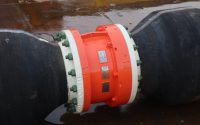U.S. Tanker Leaks Fuel in the North Sea- Major problem
NORTH SEA — Black smoke and flames billowed from a U.S.-flagged oil tanker after a dramatic collision with a cargo vessel off the coast of East Yorkshire, prompting a major emergency response.
The MV Stena Immaculate, anchored near Hull, was struck by the cargo vessel MV Solong in one of the North Sea’s busiest shipping routes. Coastguard helicopters and emergency crews were deployed as fires broke out aboard the vessels. Lifeboats ferried crew members to safety, while firefighting teams worked to bring the situation under control.
According to port authorities, a “massive fireball” erupted at the point of impact. All 37 crew members from both vessels were rescued, with one person taken to hospital. Everyone is now reported to be safely ashore.
The Stena Immaculate, operated by Florida-based Crowley Maritime, is one of 10 tankers used by the U.S. government to transport military fuel during periods of conflict or national emergency. At the time of the incident, the vessel was carrying jet fuel, which is now leaking into the sea, raising significant environmental concerns.
Environmental Impact and Response
Marine life in the area is at risk due to the fuel leak. According to environmental experts, the scale of the oil spill and its impact on aquatic life will depend on factors such as the quantity of fuel involved, how much has entered the water, and the prevailing sea and weather conditions.
Jet fuel is a highly toxic substance, and even small amounts can cause significant harm to marine ecosystems. The spill’s long-term effects could devastate fish populations, seabirds, and other species dependent on the Humber Estuary. Marine biologists warn that the toxic components of jet fuel, which can remain on the surface for extended periods, are likely to affect plankton, the foundation of the marine food chain.
As the spill progresses, concerns are growing about the cumulative impact on the marine food web. The North Sea, already stressed by overfishing and climate change, faces additional threats from this type of pollution. Species already vulnerable to habitat destruction, such as the harbour porpoise and common seal, could see their populations further impacted.
Local MP Graham Stuart issued a statement warning of the potential for serious ecological damage to the Humber Estuary and surrounding waters. “This spill is a serious blow to the environment, and immediate action is needed to contain it and mitigate its impact on local wildlife and habitats,” said Stuart.
Elaboration on the Technical Details of the Collision
The collision between the Stena Immaculate and MV Solong occurred in one of the busiest and most critical maritime corridors in the world. This route links the UK, the Netherlands, and Germany and serves as a vital artery for European shipping and offshore oil and gas operations. The region is known for its heavy traffic of large vessels, including oil tankers, cargo ships, and container ships.
At the time of the incident, both vessels were navigating the North Sea, where high traffic volumes and unpredictable weather conditions can increase the risk of accidents. According to maritime experts, the collision occurred in an area known for tight shipping lanes, where vessels are required to maintain precise navigational paths to avoid accidents.
The Stena Immaculate was on a course to offload military fuel, while the Solong was transporting goods between European ports. It is believed that both ships were moving at high speeds when the accident occurred. The high speed and force of the impact likely caused severe structural damage to both vessels, contributing to the massive fireball and the subsequent fuel leak.
While the cause of the crash is still under investigation by the Marine Accident Investigation Branch (MAIB), initial reports suggest human error or mechanical failure could be factors. Experts are also investigating the possibility of miscommunication between the vessels’ crews or a failure in automated navigational systems, which are often used in busy shipping lanes.
Both vessels are equipped with modern collision avoidance systems, such as Automatic Identification Systems (AIS) and radar, designed to alert vessels of nearby obstacles. However, experts note that weather conditions, visibility, and the speed of the vessels at the time of the collision could have played a significant role in the incident.
Coastguard and Rescue Operations
The Maritime and Coastguard Agency, along with Humber Coastguard and HM Coastguard, coordinated a large-scale rescue operation. Lifeboat crews were involved in the evacuation of the crew, while search and rescue operations continue to ensure that all personnel are accounted for. The Solong cargo ship has remained afloat, and no further casualties have been reported.
Leaking Jet Fuel and Its Environmental Consequences
At the time of the collision, the Stena Immaculate was carrying jet fuel, and the leak has raised concerns about its impact on the surrounding marine life. Jet fuel is a highly toxic substance, and even small amounts can cause significant harm to marine ecosystems. The presence of diesel oil and crude oil in the spill only exacerbates the potential environmental damage.
The collision occurred in the North Sea, a crucial area for both the shipping industry and offshore oil and gas operations. As the leak continues, experts are concerned about the broader impact on marine life and the long-term consequences for local ecosystems.
Response to the Spill
In the aftermath, search and rescue efforts continue to focus on preventing further fuel leakage and assessing the damage caused by the collision. The Marine Accident Investigation Branch (MAIB) is investigating the cause of the collision, while counter-pollution measures are being implemented to contain the spill and mitigate the environmental impact.

